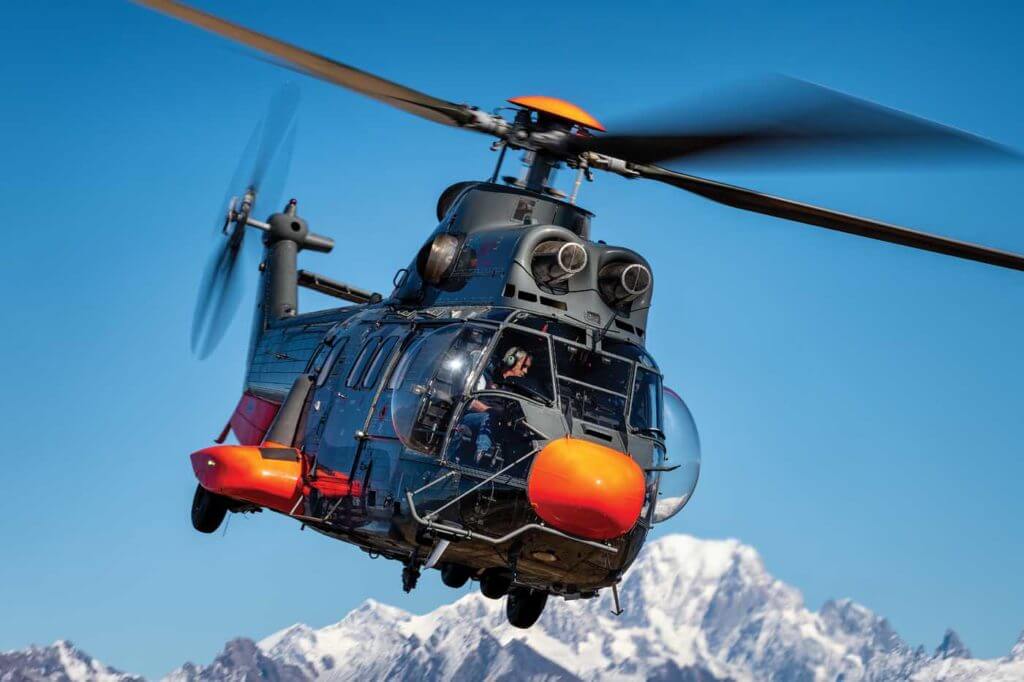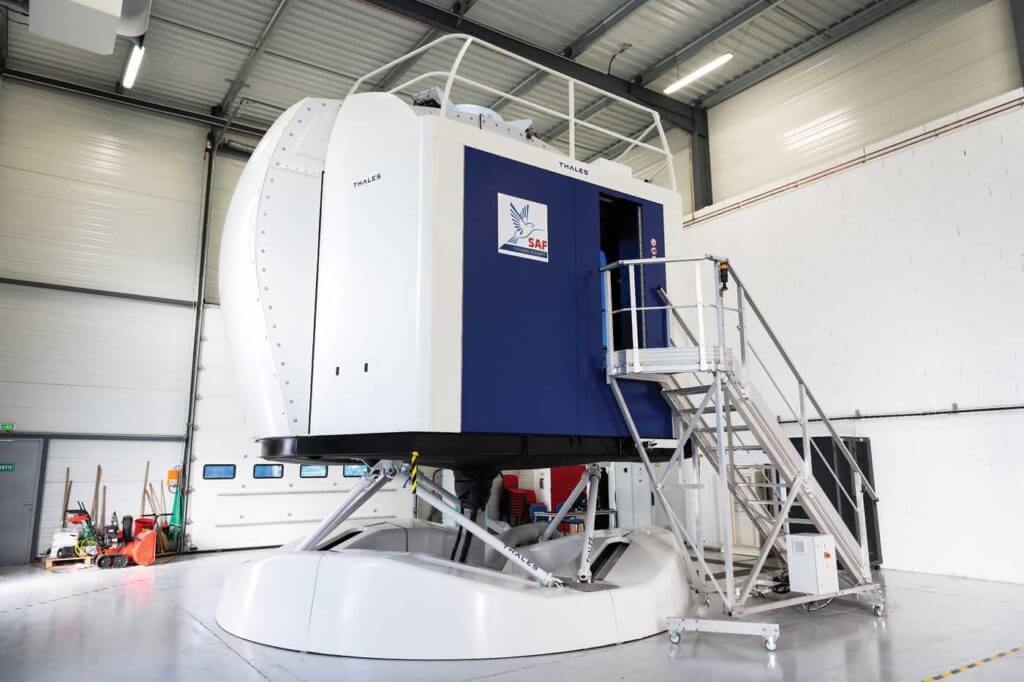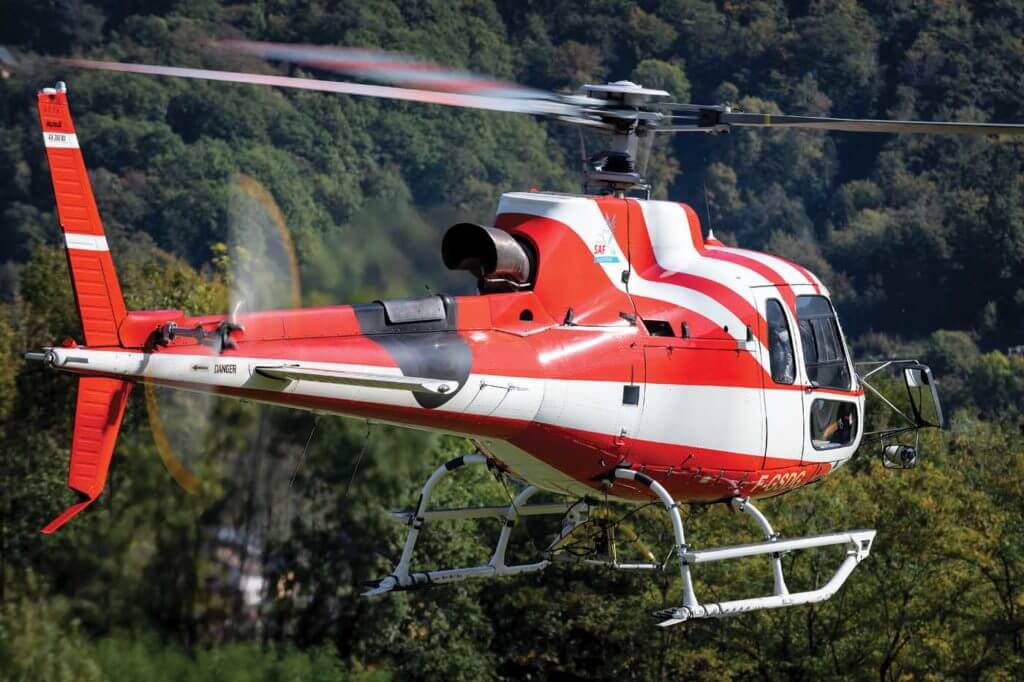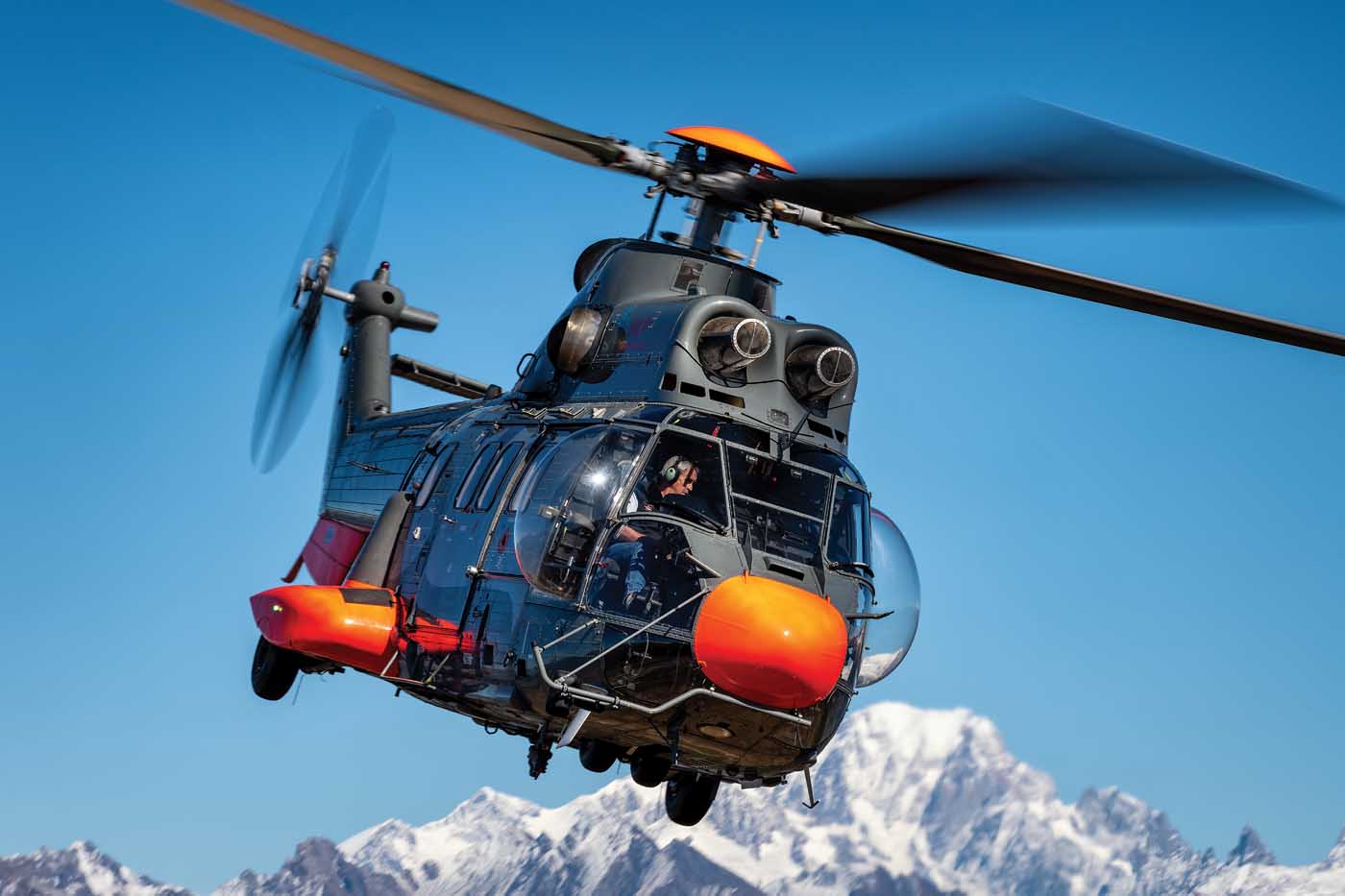In 1977, Jean Capoulade created Helicap, a helicopter company serving the Paris area. By 1983, Helicap was running the first civil helicopter emergency medical service (HEMS) operation on behalf of SAMU, the French public emergency healthcare system. Meanwhile, 300 miles (480 kilometers) south in the Savoie region of the French Alps, Roland Fraissinet founded Secours Aérien Français (SAF – French Air Rescue) in 1979, using helicopters as a lifeline for those in need of rescue in the mountains. The two companies built their experience in similar roles, and in 2006 joined forces as the SAF Group, retaining the moniker but renewing it as Services Aériens Français, to reflect their broader capabilities.
“Protection and service are in our DNA,” Tristan Serretta, group president, told Vertical. “Even with VIP and training now part of our business, our guiding principles remain the same. But a third of our air operations are still HEMS.”
SAF has diversified not only into related fields such as mountain rescue, but also utility, firefighting, survey, commercial transport and training. It has bases across France, in Morocco, and on the island of Reunion, east of Madagascar.
With such a repertoire, SAF needs a fleet that is simultaneously diverse enough to fulfill its tasks, but also made up of types that are flexible enough to take on a variety of roles. The company was the first civilian operator of the Eurocopter (now Airbus Helicopters) EC135, which is still its staple for HEMS operations. The venerable Robinson R22 and R44 make up most of its training fleet, but as a company that operates a majority Airbus fleet, it is no surprise that it has added two Hélicoptères Guimbal Cabri G2s. These are all put to work under the company’s status as a European Aviation Safety Agency (EASA) Approved Training Organisation (ATO), and along with the company’s two full-flight simulators, are used for both initial training and type ratings.

Aerial work and public transport are mostly the preserve of the workhorse Airbus AS350’s many variations, known in France as the Ecureuil (Squirrel) and elsewhere in the world as the AStar. Where heavy lifting is required, SAF has an Airbus Helicopters H215 Super Puma, capable of lifting up to 4.5 tons (9,000 pounds/4,080 kilograms).
The latest addition to the group is Azur Helicopter, a VIP and charter company based in the French Riviera. While part of the SAF Group, Azur operates on a separate air operations certificate and has its own fleet of aircraft.
Managing the group’s disparate activities is François Millian, SAF Group head of operations. Previously a pilot with the company, he worked between bases in summer and flew out of the ski resort town of Courchevel, France, in the winter, becoming the chief flying instructor before taking a year away to fly in Canada.

“I’ve flown the line, so I know the reality of the pilot’s job, although I have limited single-engine experience,” he said. However, having spent two years between 2015 and 2017 flying HEMS and rescue flights in the mountains, he is very familiar with the way that the company handles these tasks in some of the world’s most popular ski resorts, such as Courchevel and Val d’Isère.
“HEMS at Courchevel is very specifically crewed,” he explained. “It is a single-pilot operation, carrying a Gendarme [French interior ministry police] or a CRS [Police] specialized in SAR [search-and rescue], and a doctor from the hospital to stabilize the patient on-site.”
Seeing in the dark
Given that all but the foolhardiest restrain their skiing to daylight hours, the mountain rescue task in the resorts is a 12-hour operation. Four of SAF’s other HEMS operations are operating 24 hours a day, even though the complexities of French regulation mean that NVIS (night vision imaging systems) have yet to be adopted in the civil sector. This is something that Millian, and others at SAF, are working to change.
“One of our bases has been approved for a six-month NVIS trial starting in December [2019],” he said. “The training plan and the ops spec for NVGs [night vision goggles] are today validated. SAF is proud to be the first French helicopter operator at this level of expertise, and after completion, other users around the country will be able to follow.”

Developing this trial and the training plan to support it has not been easy, even though many of SAF’s pilots have NVIS experience from the military. Despite having a regulatory framework for operation, there is no EASA regulation for NVIS training, so SAF had to build the training package from the ground up.
“Civil NVIS operation is very new here,” explained Millian. “Some of our pilots from the military have used them a lot, but the French aviation authority doesn’t have a lot of experience with them.”
Also involved in this expansion of capability is Jean-Michel Delval, who is responsible for safety management at SAF. Having held a variety of posts with regulatory bodies, he understands perhaps better than most how to bridge the gaps in knowledge and experience. He explained that starting from a blank slate involved overcoming some of the organizational frictions resulting from being the ones blazing the trail.
“The first problem was ITAR,” he recalled. NVIS systems manufactured in the United States are subject to International Traffic in Arms Regulations (ITAR), and before anything else, the regulators needed to be convinced that the benefits would outweigh the considerable administrative burden involved in acquiring the necessary equipment.

Delval explained how SAF HEMS pilots have previously managed the risk of responding to calls at night. “Pilots would need to make careful approaches to suitable locations that were known to them from their own local knowledge,” he said. “If they needed to fly to an unknown site, it was necessary to closely coordinate with units on the ground.”
“The regulator had a poor understanding of how NVIS would improve safety and this had to be carefully and clearly communicated to them,” he said.
Specialist operations and unusual safety cases are not new to Delval, even though he’s just in his second year with SAF. “It’s not an easy job,” he said. “The range of operations is very broad, even though we only operate small and medium helicopters.”
One of the key complexities of Delval’s job is that EASA now regulates many more areas of operation than it has done historically, including specialist operations. Looking into the specifics of SAF’s operations, it becomes evident that this encompasses a great deal of what the company does, whether mountain HEMS or carrying explosives for avalanche control. All these tasks require specialist approvals, and some specific examples compound the complexity to a degree that would challenge any regulator, let alone the company. Delval’s first approval with SAF was an example of such a complex task.

“We were handling an offshore operation in Antarctica with two AS350s carried on board a military ship to transfer stores necessary to sustain operations during the winter season,” he said. “This included flying dangerous goods, as well as conducting hoist and sling operations, and we had to conduct the training, preparation and coordination necessary to operate a single-engine turbine in such a hostile environment.”
This was the first time that a French civilian company had taken on such a task. While undoubtedly a mammoth challenge, Delval explained that the company’s ethos is to embrace such situations. “The culture of the company is always to innovate and be proactive,” he said. “One of the biggest challenges is maintaining agility while maintaining and demonstrating compliance with regulations.”
A focus on training
Even with such ambitions, this kind of can-do attitude can only exist within a culture that allows frank discussion about what constitutes too much risk. Experienced operators must make an educated estimate of the risks involved, and the effectiveness of the mitigations. Providing a cadre of such experts is the responsibility of Laurent Jay, who has been with SAF since 2005. With eight years’ experience in HEMS, he is also an experienced mountain rescue pilot. As part of the SAF operations department, he is responsible for crew training and with such a wide variety of operations, this goes well beyond recurrent qualifications.

As well as line training of pilots, Jay conducts mountain flying specialist training and is responsible for training technical crew members and task specialists.
“We’ve got a lot of crew in the company,” he explained. “This makes it complex to plan and efficiently execute training, and a lot of training is required to make this company safe.”
As might be expected, there is a litany of training competencies that need to be kept current. Pilots fly three flight checks and two simulator checks a year and receive two to three days of theoretical tests, as well as renewing their type ratings and taking a night-flying test once a year. Technical crew members also receive theoretical knowledge training, as well as passing a simulator check involving landing and departing from confined areas or incident sites. This ensures that they can correctly alert the pilot to safety of flight hazards, including obstacles and — the nemesis of all low-level helicopter operators — wires.
SAF has developed its own bespoke software system to keep track of the litany of training requirements, but as with the rest of the operation, training requirements are collectively broad but individually specific. With their own individual requirements, it makes sense that they have their own synthetic training facility, which includes one full flight simulator (FFS) for the AS350 B3+ and another for the EC135 T2+, which is EASA Level B certified and NVIS compatible. These allow crews to train without affecting the availability of line aircraft, but Jay stresses that economics are not the driving factor in acquiring or using synthetic training systems.

“In my post I don’t look at money, I look only at the safety of the crew,” he said, pointing out that the simulators allow higher fidelity training for emergency drills than does live training. “If you don’t use a simulator you can’t follow the exact procedure,” he explained. “For example, the pilot will never have to push the fire button. In the simulation, we can practice tail rotor failure, autorotation and engine fires.”
While Jay has eyes only for the safety benefits of the simulators, Millian enjoys the associated financial value. With the nearest competitor being on the other side of the country, he can offer it to other operators for wet or dry lease. “The SAF EC135 T2+ simulator is the premier FFS in France,” he explains. “Although it is in Albertville, so not as accessible as might be desirable, almost all HEMS operators in France have training delivered in the SAF simulator, as do Geneva HEMS.”
However, some training must be conducted in the live environment. The AS350s stationed at the ski resorts of Alpe d’Huez, La Plagne and Val d’Isère all fly with a Goodrich rescue hoist fitted, as does the EC135 at Courchevel. A specially trained task specialist is required to operate the hoist, and these aircraft also fly with doctors and members of specialist ski patrols known as pisteurs. All must be familiar with the procedures and methodologies involved in complex rescue techniques, none of which can yet be fully delivered in a synthetic environment.

As ever in the mountains, it is the weather that is singled out by Jay as the greatest threat. “The weather can change very quickly,” he said. “But we have very experienced pilots.” Jay himself has over 8,000 hours flying experience including a 15-year career in the French armed forces and five years flying mountain rescue tasks.
A broad workload
It is not only rescue tasks that are carried out in the mountains. Much of the company’s utility work takes place there, and naturally it is the only environment where avalanche control operations are necessary. This places demands on the flying crews, of course. But coupled with dispersal of the company’s other aircraft around France and beyond, it also requires a dedicated engineering effort to keep them flying.
Antoine Lebecq is the engineer in charge of airworthiness at SAF, with overall responsibility for the serviceability of all the company’s aircraft. He has been with SAF for 12 years and has a technical staff of nearly 40 split between the maintenance facility at the SAF headquarters in Albertville and another in Paris.

The capabilities of the facility are impressive, and the company also provides maintenance to fulfill several contracts from the French government. “We can complete all the maintenance activities on the aircraft, as well as some of the role equipment,” said Lebecq.
He explained that having most of their aircraft from one manufacturer lessens the maintenance burden. “SAF helicopter focuses on two types, the AS350 and EC135,” he said. “It’s easier to get people trained that way.”
Maintenance crew start their training in the part 145 facility, then validate their license with either Safran or Airbus Helicopters. “It will depend on their qualifications, but it takes between six months and three years,” he explained.

Maintenance planning is greatly assisted by bespoke software, similar to that used to assist their training program, that tracks part life and stock. Also common with the training side of the business, the entire maintenance infrastructure of SAF gives the impression of a very well-found company that has invested the time and effort necessary to grow efficiently. With its experience in the sector, it is hard to imagine there being much in the way of competition, at least for the technically complex HEMS and mountain rescue operations, for which the regulatory burden alone must discourage any potential newcomers.
However, nobody at the company gave any indication that it would sit on its laurels, least of all Serretta, who outlined his vision for the future of the company as: “Reinforcing our MRO [maintenance, repair and overhaul] and training facility, modernizing the fleet, becoming more international and remaining innovative.” When challenged if that could that mean integrating unmanned operations, the reply is, “Why not?” His strategic aim for SAF is to become the only international player addressing the full spectrum of helicopter services.

This manifesto is doubtless ambitious, even for a company with such a pedigree. But there is no arguing with SAF’s track record. In nearly half a century of operation, the group has embraced the challenges of leading the helicopter market in France and beyond. While its enviable fleet of aircraft provides the technical capability to tackle the challenges that presents, SAF has depended on its people to provide the innovation, imagination and dedication to surmount the hurdles that come from being at the forefront.





